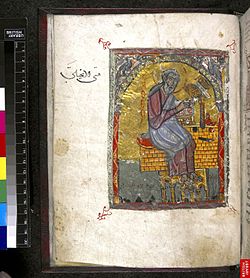- Minuscule 72
-
New Testament manuscripts
papyri • uncials • minuscules • lectionariesMinuscule 72
Folio 3 verso, portrait of the Evangelist MatthewText Gospels Date 11th century Script Greek Now at British Library Size 25.2 cm by 20 cm Type Byzantine text-type Category none Hand elegant Note Family Π
MarginaliaMinuscule 72 (in the Gregory-Aland numbering), ε 110 (von Soden),[1] is a Greek minuscule manuscript of the New Testament, on parchment leaves. Palaeographically it has been assigned to the 11th century.[2] John Mill called it Codex Ephesinus.[3] The manuscript has complex contents with full marginalia.
It is currently housed in at the British Library (Harley 5647), at London.[2]
Contents
Description
The codex contains complete text of the four Gospels on 268 leaves (size 25.2 cm by 20 cm). The text is written in one column per page, 22-24 lines per page[2] in an elegant minuscule letters.[3][4] The capital letters in red.[4]
The text is divided according to the κεφαλαια (chapters), whose numbers are given at the margin, τιτλοι (titles of chapters) at the top of the pages. There is also another division according to the smaller Ammonian Sections (Matthew 360, Mark 240 – 16:19; Luke 342, John 232), with references to the Eusebian Canons.[4]
It contains the Epistle to Carpianum, the tables of the κεφαλαια (tables of contents) before each Gospel, portraits of the four Evangelists, lectionary markings at the margin (for liturgical use), and subscriptions at the end of each Gospel, with numbers of στιχοι (in Mark).[3] It is elegantly written. It has scholia in Matthew and two scholia in Mark (16:19.20).[4]
It has various readings and personal notes in the margin of the codex written in Greek and Arabic.[3][4] The text of Matthew is surrounded by a catena (largely derived from the homilies of John Chrysostom).[3]
Text
The Greek text of the codex is a representative of the Byzantine text-type. Aland did not place it in any Category.[5] According to Hermann von Soden it is related to the Family Π.[6] It was confirmed by Kirsopp Lake.[7] According to the Claremont Profile Method it represents family Πa in Luke 1 and family Kx in Luke 10 and Luke 20.[6]
It does not contain the Pericope Adulterae (John 7:53-8:11).[8]
History
The manuscript was written in Syria or Palestina.[9]
According to Arabic notes on a margin, the manuscript was later in the property of a Presbyter David, the son of Micheal the Metropolitan of Bosra.[7] C. R. Gregory saw it in 1883.[4]
It was examined by Wettstein in 1731 and Griesbach.[4]
See also
References
- ^ Gregory, Caspar René (1908). Die griechischen Handschriften des Neuen Testament. Leipzig: J. C. Hinrichs'sche Buchhandlung. p. 50. http://www.archive.org/stream/diegriechischen00greggoog#page/n61/mode/2up.
- ^ a b c K. Aland, M. Welte, B. Köster, K. Junack, "Kurzgefasste Liste der griechischen Handschriften des Neues Testaments", Walter de Gruyter, Berlin, New York 1994, p. 50.
- ^ a b c d e Scrivener, Frederick Henry Ambrose; Edward Miller (1894). A Plain Introduction to the Criticism of the New Testament. I (4 ed.). London: George Bell & Sons. p. 204.
- ^ a b c d e f g Gregory, Caspar René (1900). Textkritik des Neuen Testaments. 1. Leipzig: Hinrichs. p. 145. http://www.archive.org/details/textkritikdesne00greggoog.
- ^ Aland, Kurt; Barbara Aland; Erroll F. Rhodes (trans.) (1995). The Text of the New Testament: An Introduction to the Critical Editions and to the Theory and Practice of Modern Textual Criticism. Grand Rapids: William B. Eerdmans Publishing Company. p. 138. ISBN 978-0-8028-4098-1.
- ^ a b Wisse, Frederik (1982). The profile method for the classification and evaluation of manuscript evidence, as Applied to the Continuous Greek Text of the Gospel of Luke. Grand Rapids: William B. Eerdmans Publishing Company. p. 54. ISBN 0-8028-1918-4.
- ^ a b Kirsopp Lake, "Family Π and the Codex Alexandrinus. The Text According to Mark", London 1936.
- ^ Scrivener, Frederick Henry Ambrose; Edward Miller (1894). A Plain Introduction to the Criticism of the New Testament. II (4 ed.). London: George Bell & Sons. p. 365.
- ^ Harley 5647 at the British Library
Further reading
- A Catalogue of the Harleian Manuscripts in the British Museum, 4 vols (London: Eyre and Strahan, 1808-12), II (1808), no. 5647.
- J. W. Burgon, The Last Twelve Verses of the Gospel According to St. Mark (Oxford and London, 1871).
- Kirsopp Lake, "Family Π and the Codex Alexandrinus. The Text According to Mark" (London 1936).
External links
- Harley 5647 at the British Library
Categories:- Greek New Testament minuscules
- 11th-century biblical manuscripts
- Harleian Collection
Wikimedia Foundation. 2010.

